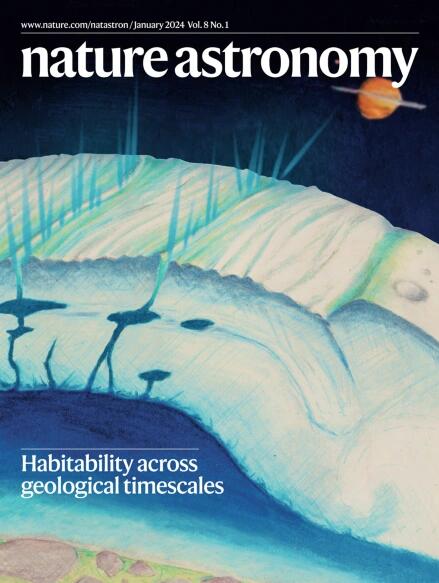闪烁毫秒脉冲星J0437−4715揭示了弓形激波和局部气泡等离子体
IF 14.3
1区 物理与天体物理
Q1 ASTRONOMY & ASTROPHYSICS
引用次数: 0
摘要
电离的星际介质包含天文单位尺度(及以下)的结构,这些结构会散射来自脉冲星的无线电波,导致闪烁。闪烁的功率谱分析通常显示抛物线弧,其曲率编码了脉冲星,地球和星际等离子体的位置和运动学。在这里,我们报告在MeerKAT射电望远镜的观测中,在明亮的毫秒脉冲星PSR J0437−4715的方向上发现了25个不同的等离子体结构。脉冲星及其风与周围星际介质相互作用时产生的一系列激波,揭示了距离脉冲星5000天文单位内的结构。测量到的主激波的径向距离和速度使我们能够在三维空间中求解脉冲星的激波几何形状和空间速度,而另一个结构的速度出人意料地表明从激波或脉冲风尾部方向的回流。剩下的21个弧线代表了令人惊讶的丰富的结构,这些结构是由局部气泡内的湍流维持的,这是一个星际介质区域,被认为是在大约14万年前的一系列超新星爆炸中耗尽了气体。局部气泡在一些区域足够冷,以至于亚天文单位的密度波动可以从湍流中产生。本文章由计算机程序翻译,如有差异,请以英文原文为准。


Bow shock and Local Bubble plasma unveiled by the scintillating millisecond pulsar J0437−4715
The ionized interstellar medium contains astronomical-unit-scale (and below) structures that scatter radio waves from pulsars, resulting in scintillation. Power spectral analysis of scintillation often shows parabolic arcs, with curvatures that encode the locations and kinematics of the pulsar, Earth and interstellar plasma. Here we report the discovery of 25 distinct plasma structures in the direction of the brilliant millisecond pulsar, PSR J0437−4715, in observations obtained with the MeerKAT radio telescope. Four arcs reveal structures within 5,000 au of the pulsar, from a series of shocks induced as the pulsar and its wind interact with the ambient interstellar medium. The measured radial distance and velocity of the main shock allow us to solve the shock geometry and space velocity of the pulsar in three dimensions, whereas the velocity of another structure unexpectedly indicates a back flow from the direction of the shock or pulsar-wind tail. The remaining 21 arcs represent a surprising abundance of structures sustained by turbulence within the Local Bubble, which is a region of the interstellar medium thought to be depleted of gas by a series of supernova explosions about 14 Myr ago. The Local Bubble is cool enough in areas for subastronomical-unit density fluctuations to arise from turbulence. A scintillating pulsar has revealed 25 plasma structures in the Local Bubble of our Galaxy, including four linked to the pulsar’s bow shock. The findings can be linked to create a three-dimensional model of the shock and uncover turbulence-driven plasma density fluctuations.
求助全文
通过发布文献求助,成功后即可免费获取论文全文。
去求助
来源期刊

Nature Astronomy
Physics and Astronomy-Astronomy and Astrophysics
CiteScore
19.50
自引率
2.80%
发文量
252
期刊介绍:
Nature Astronomy, the oldest science, has played a significant role in the history of Nature. Throughout the years, pioneering discoveries such as the first quasar, exoplanet, and understanding of spiral nebulae have been reported in the journal. With the introduction of Nature Astronomy, the field now receives expanded coverage, welcoming research in astronomy, astrophysics, and planetary science. The primary objective is to encourage closer collaboration among researchers in these related areas.
Similar to other journals under the Nature brand, Nature Astronomy boasts a devoted team of professional editors, ensuring fairness and rigorous peer-review processes. The journal maintains high standards in copy-editing and production, ensuring timely publication and editorial independence.
In addition to original research, Nature Astronomy publishes a wide range of content, including Comments, Reviews, News and Views, Features, and Correspondence. This diverse collection covers various disciplines within astronomy and includes contributions from a diverse range of voices.
 求助内容:
求助内容: 应助结果提醒方式:
应助结果提醒方式:


